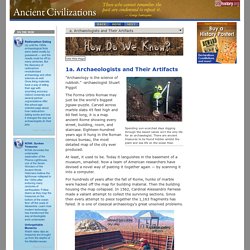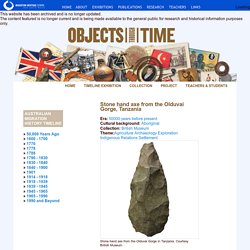

Britannica School - login through Oliver and search "ancient civilization" in middle school. Key Components of Civilization - National Geographic Society. The earliest civilizations developed between 4000 and 3000 BCE, when the rise of agriculture and trade allowed people to have surplus food and economic stability.

Many people no longer had to practice farming, allowing a diverse array of professions and interests to flourish in a relatively confined area. Civilizations first appeared in Mesopotamia (what is now Iraq) and later in Egypt. Civilizations thrived in the Indus Valley by about 2500 BCE, in China by about 1500 BCE and in Central America (what is now Mexico) by about 1200 BCE.
Civilizations ultimately developed on every continent except Antarctica. Archaeologists and Their Artifacts. Spending sun-scorched days digging through the desert sands isn't the only life for an archaeologist.

There are ancient treasures to be found hidden amidst the plant and sea life on the ocean floor. "Archaeology is the science of rubbish. " Lost civilisations from above - Google Earth. Human Odyssey Map: California Academy of Sciences. Australia's migration history timeline. Aboriginal rock painting of Macassan prahu in Arnhem Land, c.2011.

Courtesy Australian National University Homo sapiens or humans evolved in Africa about 200,000 years ago, reaching modernity about 50,000 years ago. Prior to the arrival of humans in Europe, the Middle East and Asia, these places were inhabited by another species of hominoid, Homo heidelbergensis or Neanderthals. Neanderthals begin to show on the archaeological record at around 400,000 years ago and became extinct at about 35,000 years ago with the arrival of humans. Stone hand axe from the Olduvai Gorge, Tanzania. Era: 50000 years before presentCultural background: AboriginalCollection: British MuseumTheme:Agriculture Archaeology Exploration Indigenous Relations Settlement Stone hand axe from the Olduvai Gorge in Tanzania.

Courtesy British Museum Collection British Museum, London, England. Object Name Stone hand axe from the Olduvai Gorge, Tanzania. The Voyages Of Discovery, State Library of NSW. Intro Greek and Roman philosophers had predicted the existence of a great southern landmass some 2000 years ago.

As the earth was a sphere, they believed there must be a huge continent to the south to counterbalance the continents in the north. Reasons for European Exploration. History of Europe - The emergence of modern Europe, 1500–1648. The 16th century was a period of vigorous economic expansion. This expansion in turn played a major role in the many other transformations—social, political, and cultural—of the early modern age. By 1500 the population in most areas of Europe was increasing after two centuries of decline or stagnation.
First Contact (Indigenous perspective) The Rabbits Part 1. The Rabbits Part 2. Frontier conflicts. Impact of colonisation on Aboriginal peoples. Aboriginal and TSI rights.